AFFF Exposure Side Effects and Long-term Health Risks
- Last Updated: June 12th, 2025

Attorney Jessica Paluch-Hoerman, founder of TruLaw, has over 28 years of experience as a personal injury and mass tort attorney, and previously worked as an international tax attorney at Deloitte. Jessie collaborates with attorneys nationwide — enabling her to share reliable, up-to-date legal information with our readers.
Legally Reviewed
This article has been written and reviewed for legal accuracy and clarity by the team of writers and legal experts at TruLaw and is as accurate as possible. This content should not be taken as legal advice from an attorney. If you would like to learn more about our owner and experienced injury lawyer, Jessie Paluch, you can do so here.
Fact-Checked
TruLaw does everything possible to make sure the information in this article is up to date and accurate. If you need specific legal advice about your case, contact us by using the chat on the bottom of this page. This article should not be taken as advice from an attorney.
Key takeaways:
- Exposure to AFFF firefighting foam containing PFAS chemicals has been linked to an increased risk of kidney, testicular, bladder, and prostate cancers, as well as other health problems like thyroid disease and immune system disorders.
- Firefighters, military personnel, chemical plant workers, and airport safety crews face a higher risk of occupational exposure to AFFF, while communities near facilities using or manufacturing the foam may be exposed through contaminated drinking water.
- Victims of AFFF exposure who develop serious health conditions like cancer may be eligible to file lawsuits seeking compensation for medical expenses, lost income, pain and suffering, and punitive damages.
Overview of AFFF Exposure
On this page, we’ll discuss AFFF Exposure, the health risks associated with exposure to firefighting foam, who is most at risk for AFFF exposure, and much more.
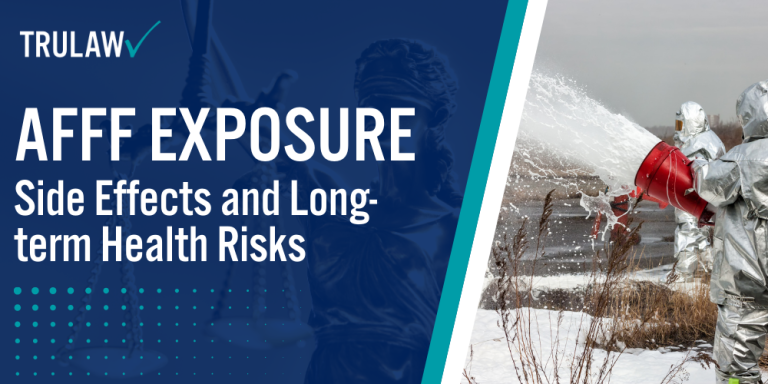
Intro to AFFF Exposure
Exposure to AFFF can occur in various settings that include, but are not limited to:
- Military Bases: Service members, particularly those involved in firefighting training or response, are at high risk of AFFF exposure.
- Airports: Civilian and military airport personnel may be exposed to AFFF during training exercises or emergency response situations.
- Firefighter Training Facilities: Firefighters and trainees can be exposed to AFFF during training exercises and simulations.
- Industrial Facilities: Workers at industrial sites where AFFF is used for fire suppression may be at risk of exposure.
If you have been exposed to AFFF and have been diagnosed with related health issues, you may be entitled to compensation through an AFFF lawsuit.
Contact TruLaw today using the chat on this page for a free case evaluation to determine your eligibility for an AFFF lawsuit.
Table of Contents
Health Risks of AFFF Exposure
Exposure to AFFF firefighting foam is a significant concern, mainly due to the presence of PFAS, chemicals that have been linked to several serious health conditions.
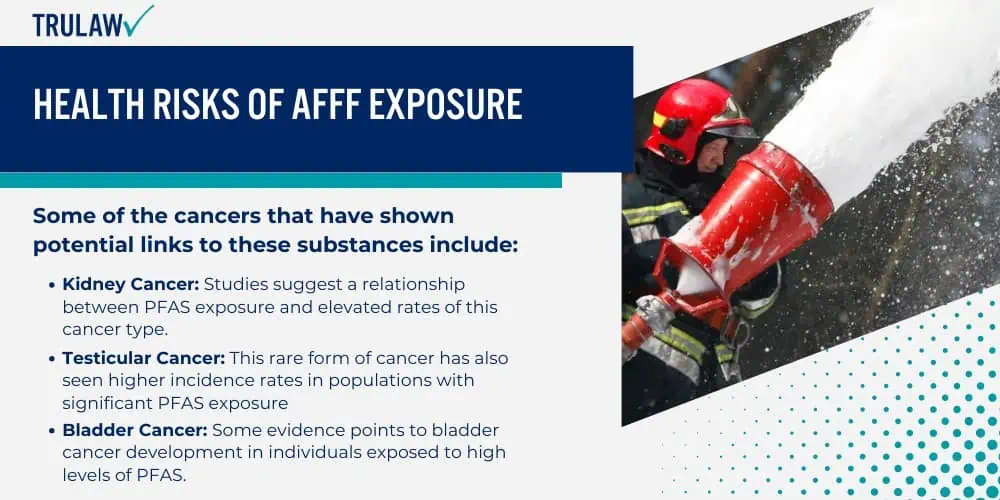
Types of Cancers Linked to AFFF
PFAS contamination from AFFF, often referred to as “forever chemicals” due to their persistence in the environment, has been associated with an increased risk of various types of cancers.
Some of the cancers that have shown potential links to these substances include:
- Kidney Cancer: Studies suggest a relationship between PFAS exposure and elevated rates of this cancer type.
- Testicular Cancer: This rare form of cancer has also seen higher incidence rates in populations with significant PFAS exposure.
- Bladder Cancer: Some evidence points to bladder cancer development in individuals exposed to high levels of PFAS.
- Prostate Cancer: Research is ongoing to understand the full impact of AFFF exposure and the subsequent risk of developing this form of cancer.
Other Health Problems Caused by PFAS in AFFF
Beyond cancer, AFFF and the potentially harmful substances it contains, including PFAS, have been connected to a range of other health problems.
Here we list other negative effects identified:
- Reproductive Health: Exposure to PFAS can lead to reproductive issues and hormonal imbalances.
- Thyroid Disease: There is a strong link between PFAS exposure and thyroid illnesses, which can cause a host of severe health complications.
- Immune System Disorders: PFAS can impact the immune system, potentially reducing its efficacy and increasing susceptibility to infections.
- Respiratory System Issues: Toxic exposure may also cause problems within the respiratory system, although further investigation is ongoing to determine the extent.
Research indicates a breadth of negative health effects stemming from PFAS in AFFF, with continuous discovery shedding light on the health risks faced by those exposed to these toxic firefighting foams.
Who is at Risk of AFFF Exposure?
Exposure to Aqueous Film Forming Foam (AFFF) poses a health risk, primarily through occupational contact and contaminated drinking water.
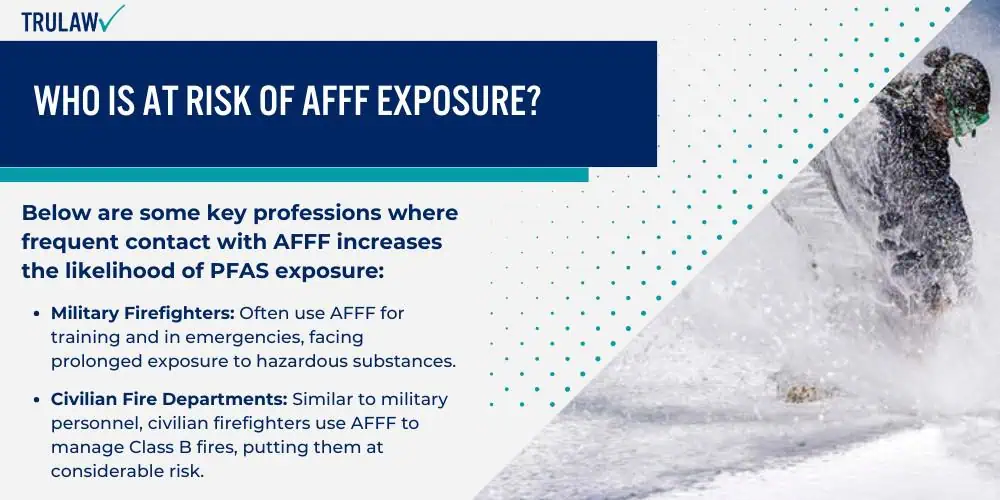
Understanding who is most at risk helps to enhance occupational safety and protect public health.
Occupational Exposure to AFFF
Persons whose work involves frequent contact with AFFF are at higher risk of exposure.
The human body can absorb PFAS chemicals in AFFF through skin contact, inhalation, or ingestion.
Below are some key professions where frequent contact with AFFF increases the likelihood of PFAS exposure:
- Military Firefighters: Often use AFFF for training and in emergencies, facing prolonged exposure to hazardous substances.
- Civilian Fire Departments: Similar to military personnel, civilian firefighters use AFFF to manage Class B fires, putting them at considerable risk.
- Chemical Plant Workers: Such facilities may use AFFF for fire suppression, hence workers might be exposed during manufacturing or firefighting activities.
- Airport Fire and Safety Personnel: Engage with AFFF during airfield emergency responses involving flammable liquids.
These occupations increase the chances of direct contact with AFFF and elevate the risk of experiencing the associated health risks over time.
Exposure to AFFF in Drinking Water
Communities located near facilities that use or manufacture AFFF may experience exposure through drinking water.
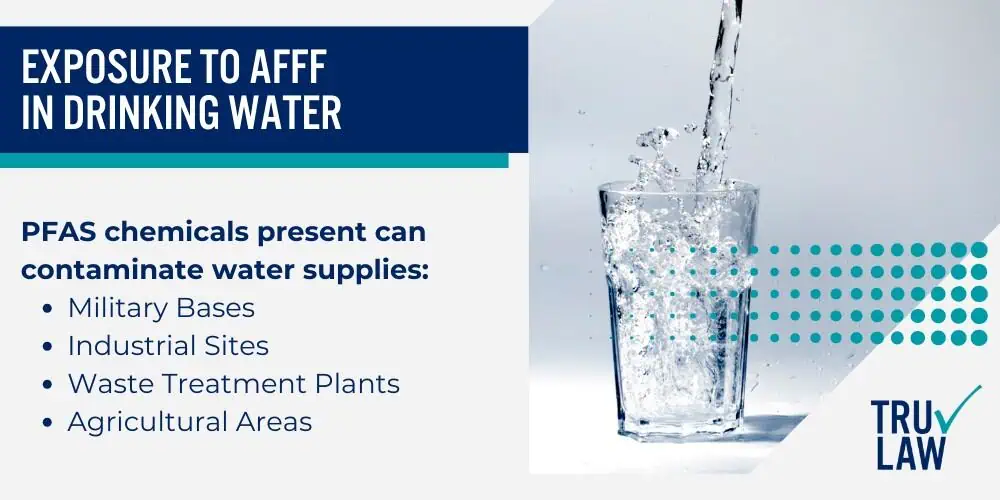
PFAS chemicals present can contaminate water supplies:
- Military Bases: Areas surrounding these facilities may have increased levels of PFAS due to historical AFFF usage.
- Industrial Sites: Factories that produce or utilize AFFF contribute to the contamination of groundwater and surface water.
- Waste Treatment Plants: If improperly treated, wastewater containing AFFF can release PFAS into the environment.
- Agricultural Areas: The use of contaminated water for irrigation can introduce PFAS into the soil and crops.
Drinking water that contains PFAS from AFFF represents one of the most significant risks to the public health of nearby communities.
Identifying and managing these risks is crucial to protect those at the highest risk.
Symptoms and Diagnosis of AFFF-Related Illnesses
When examining the potential health ramifications of AFFF exposure, it’s important to recognize specific symptoms indicative of PFAS exposure and understand the necessary medical tests to diagnose.
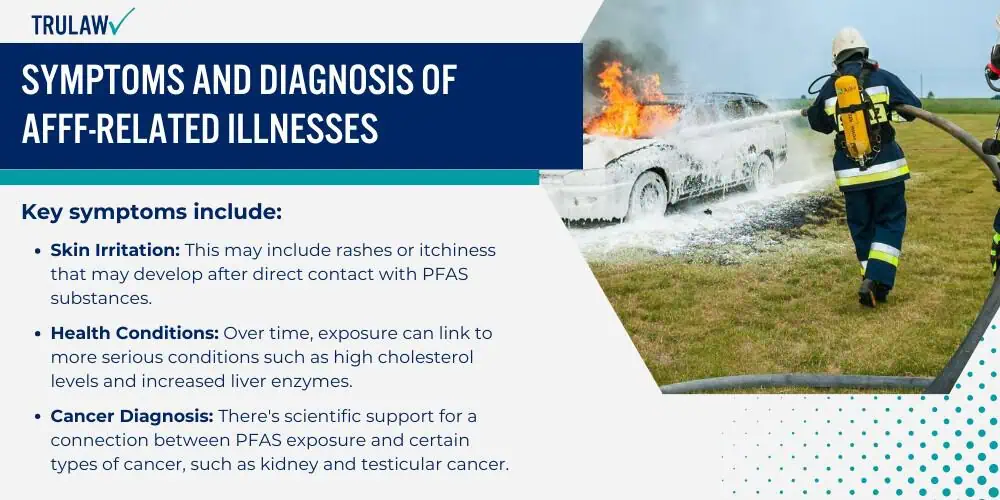
Common Symptoms of PFAS Exposure
Individuals exposed to AFFF may present a range of symptoms attributed to PFAS.
Key symptoms include:
- Skin Irritation: This may include rashes or itchiness that may develop after direct contact with PFAS substances.
- Health Conditions: Over time, exposure can link to more serious conditions such as high cholesterol levels and increased liver enzymes.
- Cancer Diagnosis: There’s scientific support for a connection between PFAS exposure and certain types of cancer, such as kidney and testicular cancer.
- Afflicted Individuals might also experience changes in thyroid function or signs of immune system weakening, such as increased susceptibility to infections.
Medical Tests to Diagnose AFFF Health Effects
Several medical tests help identify health effects stemming from AFFF exposure.
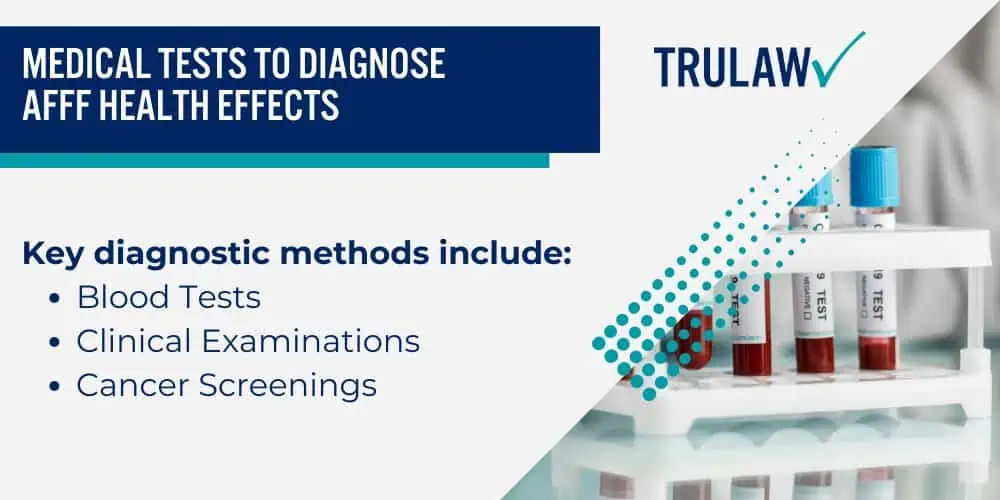
Key diagnostic methods include:
- Blood Tests: These can measure the levels of PFAS compounds in the blood and provide information on potential body burdens.
- Clinical Examinations: Comprehensive health evaluations consider the entirety of an individual’s exposure and symptomatology.
- Cancer Screenings: Specific screenings may be recommended if there is a plausible link to PFAS-related cancer development.
Regular monitoring of basic physiological parameters such as cholesterol and liver function tests may also indicate systemic effects of PFAS.
By understanding the symptoms associated with AFFF and utilizing targeted diagnostic tests, healthcare professionals can better manage and address potential health impacts.
Treatment for Health Conditions Caused by AFFF
When addressing the health risks associated with AFFF exposure, it’s important to understand that medical and lifestyle interventions can help mitigate some negative health effects.
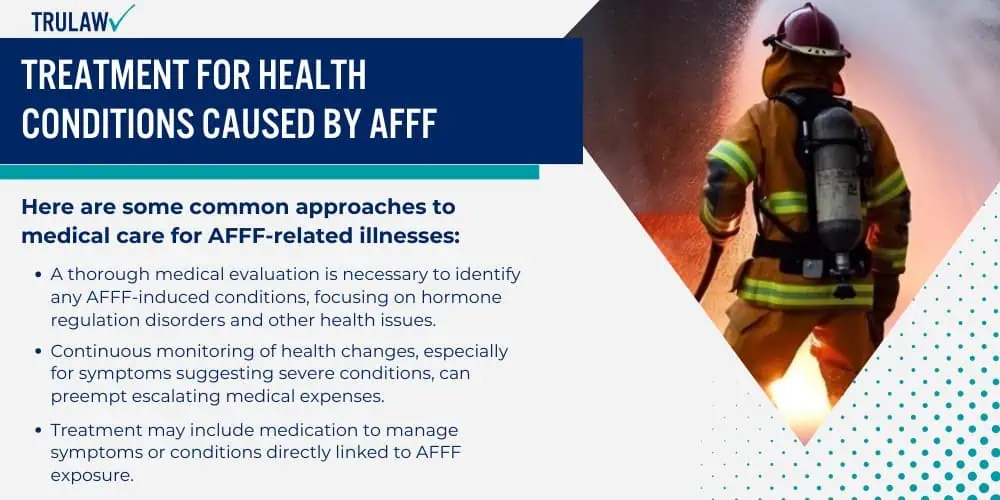
Treatment strategies should be tailored to individual needs, possibly involving medical supervision and lifestyle adjustments.
Medical Care for AFFF-Related Illnesses
Medical professionals may recommend a specific care plan when someone has been exposed to AFFF and is facing health conditions.
This treatment can vary based on the severity of symptoms and the specific health complications involved.
Here are some common approaches to medical care for AFFF-related illnesses:
- A thorough medical evaluation is necessary to identify any AFFF-induced conditions, focusing on hormone regulation disorders and other health issues.
- Continuous monitoring of health changes, especially for symptoms suggesting severe conditions, can preempt escalating medical expenses.
- Treatment may include medication to manage symptoms or conditions directly linked to AFFF exposure.
- In cases of significant exposure, healthcare providers might suggest regular blood tests to monitor for persisting substances related to AFFF.
Lifestyle Changes to Improve Health After AFFF Exposure
In addition to medical treatments, several lifestyle changes can potentially support better health following exposure to AFFF.
These adjustments can help the body recover and minimize further health risks.
Here are some lifestyle changes that can promote recovery and improve health after AFFF exposure:
- Adopting a diet that supports detoxification and hormonal balance may help mitigate some of the negative health effects.
- Regular physical activity can improve overall health and possibly expedite the body’s elimination of toxic substances.
- Avoiding further contact with known sources of AFFF and related chemicals is essential for preventing additional exposure.
- Stress management techniques are recommended, as chronic stress can disrupt hormone regulation and impede recovery.
Legal Options for AFFF Exposure Victims
Victims of AFFF exposure who have developed health conditions, such as cancer, might have legal recourse to seek compensation.
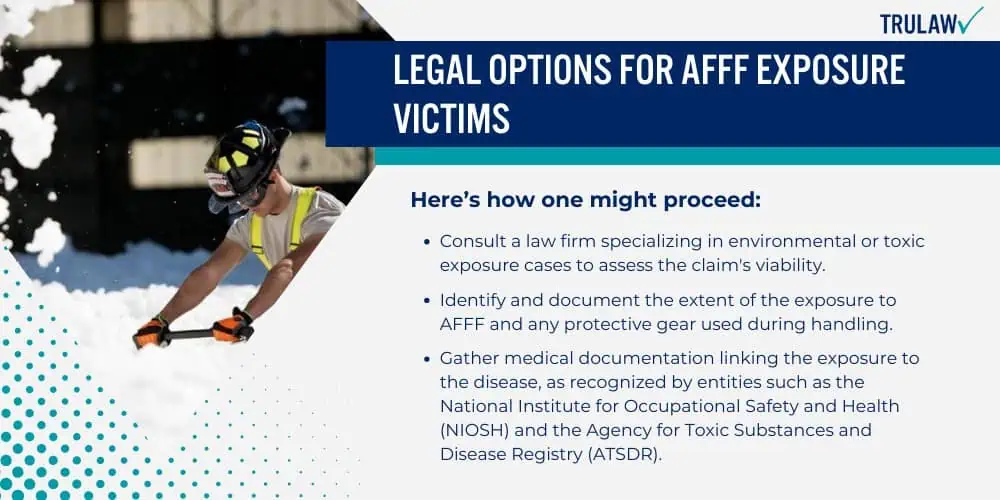
Here are specifics about initiating a lawsuit and the types of compensation that may be available.
Filing an AFFF Lawsuit
Victims of AFFF exposure, including civilian firefighters and military personnel, can consider filing an AFFF lawsuit if they have developed health problems like cancer believed to be caused by the foams.
Here’s how one might proceed:
- Consult a law firm specializing in environmental or toxic exposure cases to assess the claim’s viability.
- Identify and document the extent of the exposure to AFFF and any protective gear used during handling.
- Gather medical documentation linking the exposure to the disease, as recognized by entities such as the National Institute for Occupational Safety and Health (NIOSH) and the Agency for Toxic Substances and Disease Registry (ATSDR).
- Determine the responsible parties, which may include manufacturers of AFFF or entities responsible for unsafe working conditions.
Compensation Available in AFFF Lawsuits
Exposure to AFFF can lead to serious health risks, including certain cancers and other chronic illnesses.
Lawsuits filed by victims often focus on the responsibility of manufacturers and distributors for producing and marketing potentially hazardous products.
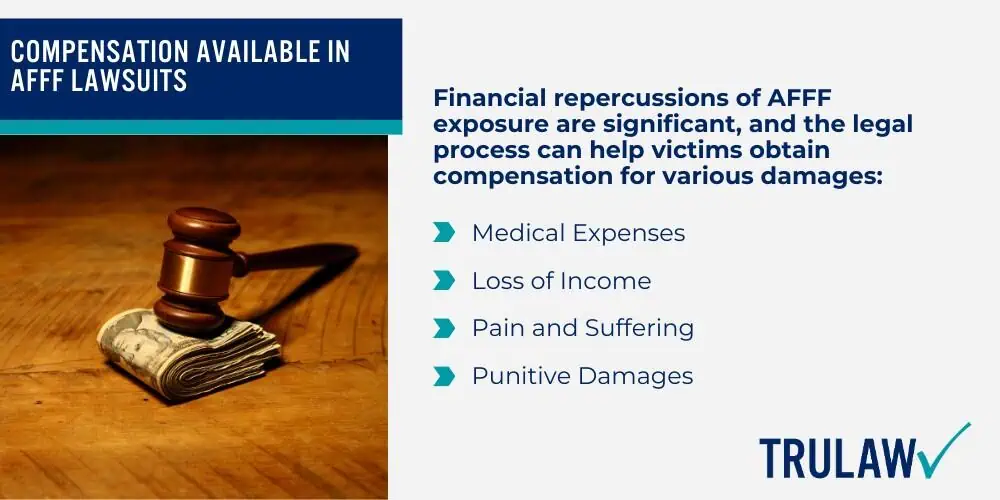
Financial repercussions of AFFF exposure are significant, and the legal process can help victims obtain compensation for various damages:
- Medical Expenses: Coverage for past and future treatments related to ailments from AFFF.
- Loss of Income: Compensation for wages lost due to illness and inability to work.
- Pain and Suffering: Recognition of the physical and emotional distress endured because of the exposure.
- Punitive Damages: In some cases, additional compensation is awarded to punish the negligent parties.
Victims seeking compensation should secure legal assistance to understand the full spectrum of what can be claimed.
Legal experts can help navigate the detailed documentation and proof required to demonstrate the connection between AFFF use and subsequent illness.
AFFF Lawsuit Frequently Asked Questions
-
What are the recognized symptoms of exposure to fire-fighting foams?
Symptoms stemming from exposure to fire-fighting foams can include skin irritations, such as rashes, and flu-like symptoms, such as fever or headaches.
Some individuals might also experience issues like eye irritation or nausea.
-
Which types of cancer have been linked to fire-fighting foam exposure?
Several types of cancer have been associated with fire-fighting foam exposure, notably testicular cancer, kidney cancer, pancreatic cancer, and prostate cancer.
Additionally, there have been reports of bladder and leukemia cases related to this exposure.
-
How is exposure to fire-fighting foam treated?
Treatment for AFFF exposure is typically symptomatic, focusing on managing symptoms as they arise.
In cases of severe contamination, treatments may include methods to remove toxins from the body, such as chelation or activated charcoal.
-
Are veterans eligible for disability compensation due to fire-fighting foam exposure?
Yes, veterans may be eligible for disability compensation if their AFFF exposure occurred during military service and they’ve developed related health conditions.
The Honoring Our PACT Act of 2022 expanded healthcare eligibility for veterans exposed to toxic substances.
-
What are the long-term health effects associated with AFFF exposure?
Long-term health effects from AFFF exposure may include an elevated risk of developing cancer, liver damage, thyroid disease, and immune system disorders.
Other concerns encompass hormonal imbalances and potential reproductive issues.
-
Is there ongoing litigation related to health issues from AFFF exposure?
Indeed, a number of lawsuits are currently active concerning health issues attributed to AFFF exposure.
These litigations primarily target foam manufacturers, arguing negligence in informing users of the associated health risks.

Managing Attorney & Owner
With over 25 years of legal experience, Jessica Paluch-Hoerman is an Illinois lawyer, a CPA, and a mother of three. She spent the first decade of her career working as an international tax attorney at Deloitte.
In 2009, Jessie co-founded her own law firm with her husband – which has scaled to over 30 employees since its conception.
In 2016, Jessie founded TruLaw, which allows her to collaborate with attorneys and legal experts across the United States on a daily basis. This hypervaluable network of experts is what enables her to share the most reliable, accurate, and up-to-date legal information with our readers!
Additional AFFF Lawsuit resources on our website:
Here, at TruLaw, we’re committed to helping victims get the justice they deserve.
Alongside our partner law firms, we have successfully collected over $3 Billion in verdicts and settlements on behalf of injured individuals.
Would you like our help?
At TruLaw, we fiercely combat corporations that endanger individuals’ well-being. If you’ve suffered injuries and believe these well-funded entities should be held accountable, we’re here for you.
With TruLaw, you gain access to successful and seasoned lawyers who maximize your chances of success. Our lawyers invest in you—they do not receive a dime until your lawsuit reaches a successful resolution!
AFFF Lawsuit claims are being filed against manufacturers of aqueous film-forming foam (AFFF), commonly used in firefighting.
Claims allege that companies such as 3M, DuPont, and Tyco Fire Products failed to adequately warn users about the potential dangers of AFFF exposure — including increased risks of various cancers and diseases.
Depo Provera Lawsuit claims are being filed by individuals who allege they developed meningioma (a type of brain tumor) after receiving Depo-Provera birth control injections.
A 2024 study found that women using Depo-Provera for at least 1 year are five times more likely to develop meningioma brain tumors compared to those not using the drug.
Suboxone Tooth Decay Lawsuit claims are being filed against Indivior, the manufacturer of Suboxone, a medication used to treat opioid addiction.
Claims allege that Indivior failed to adequately warn users about the potential dangers of severe tooth decay and dental injuries associated with Suboxone’s sublingual film version.
Social Media Harm Lawsuits are being filed against social media companies for allegedly causing mental health issues in children and teens.
Claims allege that companies like Meta, Google, ByteDance, and Snap designed addictive platforms that led to anxiety, depression, and other mental health issues without adequately warning users or parents.
Transvaginal Mesh Lawsuits are being filed against manufacturers of transvaginal mesh products used to treat pelvic organ prolapse (POP) and stress urinary incontinence (SUI).
Claims allege that companies like Ethicon, C.R. Bard, and Boston Scientific failed to adequately warn about potential dangers — including erosion, pain, and infection.
Bair Hugger Warming Blanket Lawsuits involve claims against 3M — alleging their surgical warming blankets caused severe infections and complications (particularly in hip and knee replacement surgeries).
Plaintiffs claim 3M failed to warn about potential risks — despite knowing about increased risk of deep joint infections since 2011.
Baby Formula NEC Lawsuit claims are being filed against manufacturers of cow’s milk-based baby formula products.
Claims allege that companies like Abbott Laboratories (Similac) and Mead Johnson & Company (Enfamil) failed to warn about the increased risk of necrotizing enterocolitis (NEC) in premature infants.
Here, at TruLaw, we’re committed to helping victims get the justice they deserve.
Alongside our partner law firms, we have successfully collected over $3 Billion in verdicts and settlements on behalf of injured individuals.
Would you like our help?
